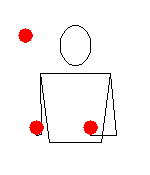
Claude Elwood Shannon was an American mathematician, electrical engineer, and cryptographer known as "the father of information theory". Shannon is noted for having founded information theory with a landmark paper, A Mathematical Theory of Communication, that he published in 1948.
The tilde is a grapheme with several uses. The name of the character came into English from Spanish and from Portuguese, which in turn came from the Latin titulus, meaning "title" or "superscription".

Ronald Lewis "Ron" Graham is an American mathematician credited by the American Mathematical Society as being "one of the principal architects of the rapid development worldwide of discrete mathematics in recent years". He has done important work in scheduling theory, computational geometry, Ramsey theory, and quasi-randomness.

Siteswap is a juggling notation used to describe or represent juggling patterns. Siteswap may also be used to describe siteswap patterns, possible patterns transcribed using siteswap. It encodes the number of beats of each throw, which is related to their relative height, and the hand to which the throw is to be made: "The idea behind siteswap is to keep track of the order that balls are thrown and caught, and only that." It is an invaluable tool in determining which combinations of throws yield valid juggling patterns for a given number of objects, and has led to previously unknown patterns. However, it does not describe body movements such as behind-the-back and under-the-leg. Siteswap assumes that, "throws happen on beats that are equally spaced in time."

Juggling clubs are a prop used by jugglers. Juggling clubs are often simply called clubs by jugglers and sometimes are referred to as pins or batons by non-jugglers. Clubs are one of the three most popular props used by jugglers; the others being balls and rings.

In toss juggling, the box is a juggling pattern for 3 objects, most commonly balls or bean bags. Two balls are dedicated to a specific hand with vertical throws, and the third ball is thrown horizontally between the two hands. Its siteswap is (4,2x)(2x,4).

Passing is the act of juggling between two or more people. It is most commonly seen as a subset of toss juggling, pass juggling.
Vladimir, known as Vova, and Olga Galchenko are a brother and sister juggling team originally from Russia. They specialize in club juggling, particularly technical solo juggling, technical club passing and numbers club passing.
Juggling world records comprise the best performances in the fields of endurance and numbers juggling.
A mathemagician is a mathematician who is also a magician.
Since the late 1980s, a large juggling culture has developed, revolving around local clubs and organizations, special events, shows, magazines, video sharing websites, Internet forums, juggling competitions and juggling conventions. Populating the scene are many juggling celebrities who are notable for being good or creative jugglers, entertaining performers, convention organizers, experts in their field, having a strong presence online or just for having an interesting personality, character or style.
When you pulled out three balls in 1973, what was going through people's minds was, 'I saw a deformed midget do that once.' But when you pulled out three balls in the '80s, it was, 'a guy in my dorm room used to do that.'

A juggling pattern or juggling trick is a specific manipulation of props during the practice of juggling. "Juggling, like music, combines abstract patterns and mind-body coordination in a pleasing way." Descriptions of patterns and tricks have been most common in toss juggling. A juggling pattern in toss juggling is a sequence of throws and catches using a certain number of props which is repeated continuously. Patterns include simple ones such as the cascade and complex ones such as Mills mess. A juggling trick in toss juggling is a throw or catch which is different from the throws and catches within a pattern. Tricks include simple ones such as a high throw or more difficult ones such a catch on the back of the jugglers neck, as well as the claw, multiplex, and pass. Systems of juggling notation have been created to describe juggling patterns and tricks. One of these is siteswap notation.
JIS X 0212 is a Japanese Industrial Standard defining a coded character set for encoding supplementary characters for use in Japanese. This standard is intended to supplement JIS X 0208. It is numbered 953 or 5049 as an IBM code page.
JIS X 0208 is a 2-byte character set specified as a Japanese Industrial Standard, containing 6879 graphic characters suitable for writing text, place names, personal names, and so forth in the Japanese language. The official title of the current standard is 7-bit and 8-bit double byte coded KANJI sets for information interchange. It was originally established as JIS C 6226 in 1978, and has been revised in 1983, 1990, and 1997. It is also called Code page 952 by IBM. The 1978 version is also called Code page 955 by IBM.
Phyllis Zweig Chinn is an American mathematician who holds a professorship in mathematics, women's studies, and teaching preparation at Humboldt State University in California. Her publications concern graph theory, mathematics education, and the history of women in mathematics.

The Association of Radio Industries and Businesses (ARIB) STD-B24 standard for Broadcast Markup Language specifies, amongst other details, a character encoding for use in Japanese-language broadcasting. It was introduced on 1999-10-26. The latest revision is version 6.3 as of 2016-07-06.












